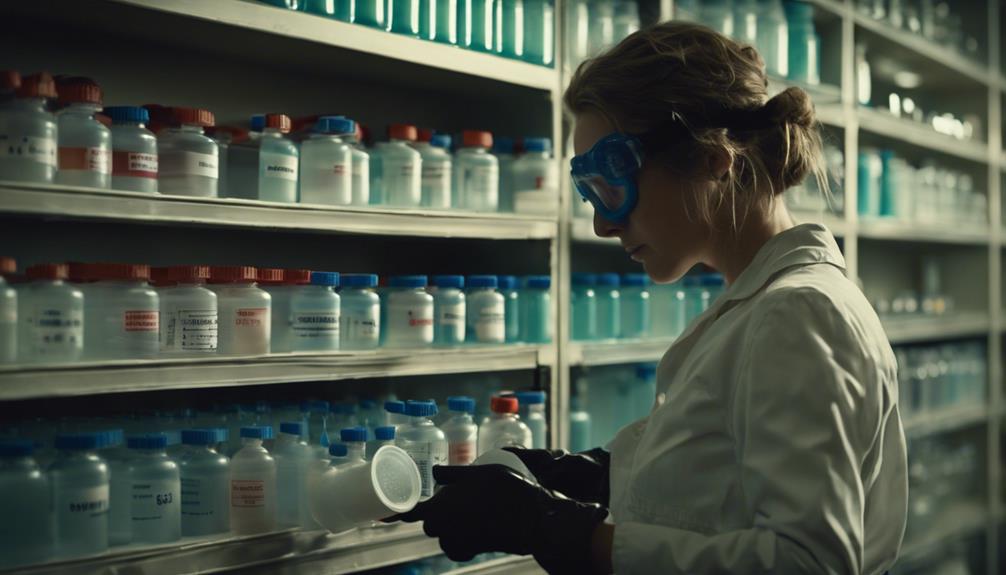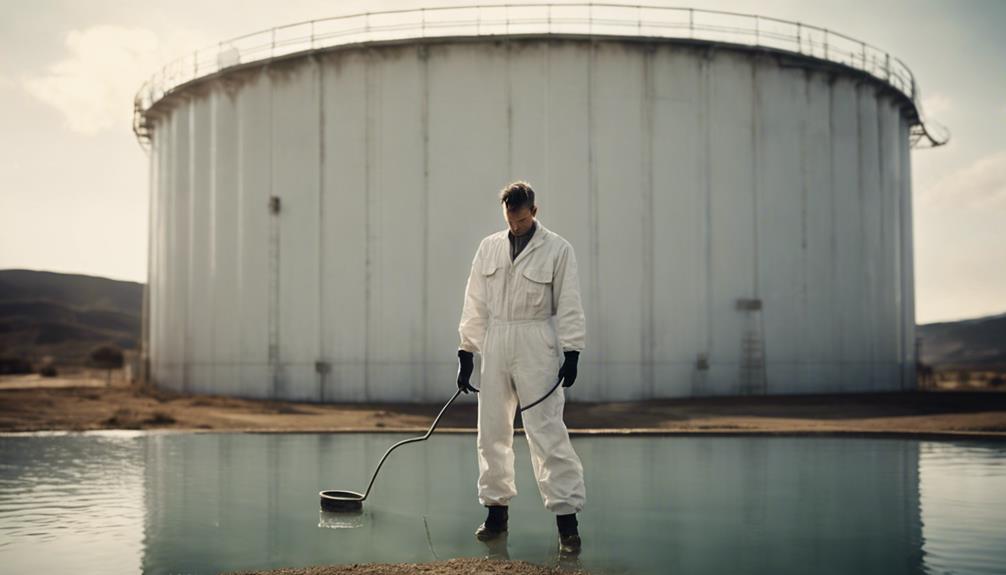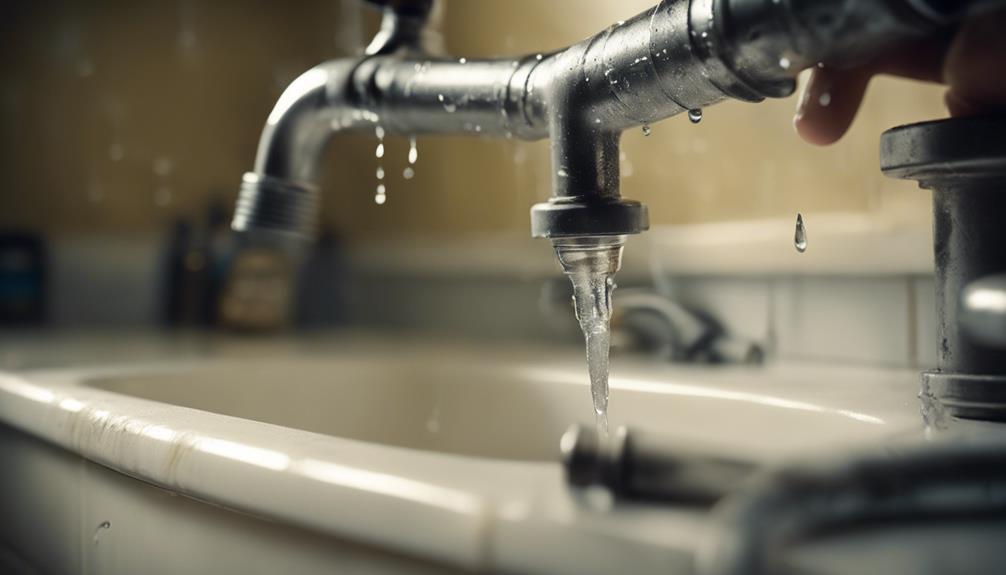You take proactive steps to maintain the quality of your water supply by regularly inspecting storage tanks, preventing algae growth, handling water treatment chemicals safely, and monitoring for signs of contamination or pollution. Inspect your tanks quarterly to identify signs of corrosion, rust, or sediment buildup. Prevent algae growth by increasing water circulation, reducing excess nutrients, and maintaining opaque storage tanks. Handle water treatment chemicals with care, following manufacturer's instructions and wearing protective gear. Regularly check for leaks and damage to prevent water waste and identify potential issues early on. Now, discover how to take your water maintenance to the next level.
Table of Contents
Key Takeaways
- Regularly inspect and maintain storage tanks to prevent contamination and ensure water quality.
- Reduce excess nutrients in waterways to prevent algae growth and maintain water freshness.
- Handle water treatment chemicals with care, following manufacturer's instructions to avoid exposure to harmful effects.
- Monitor local water supplies regularly to identify potential issues and ensure safety.
- Inspect pipes regularly to detect leaks or damage, preventing water waste and costly repairs.
Regularly Inspect Storage Tanks
You should inspect your water storage tanks at least quarterly to verify they remain clean and free of contaminants.
This regular check-up is essential to guarantee your water supply stays safe for consumption. During inspections, look for signs of corrosion, rust, or sediment buildup, which can compromise the tank's integrity and contaminate your water.
It's also necessary to check for any leaks or spills, especially if you're storing used oil or other hazardous materials nearby. If you identify any issues, take prompt action to address them, and consider consulting a hazardous waste facility for proper disposal.
Regular inspections can help prevent costly repairs, reduce the risk of waterborne diseases, and maintain the overall quality of your water supply.
In addition, it's imperative to keep accurate records of your inspections, including any maintenance or repairs performed. By staying on top of tank maintenance, you'll be able to identify potential problems early on and take proactive steps to keep your water fresh and clean.
Prevent Algae Growth Naturally
As you work to prevent algae growth naturally, you'll want to focus on reducing the flow of nutrients into your water storage system, since excess nutrients can fuel algae blooms.
You can also take steps to increase water circulation, which can help prevent stagnation and reduce the likelihood of algae growth.
Reduce Nutrient Flow
By reducing the flow of excess nutrients into waterways, individuals can prevent algae growth naturally and maintain water quality.
You can play a significant role in keeping your water clean by reducing the amount of pollutants that enter storm drains and waterways.
One way to do this is by using porous materials like gravel, paver stones, or wood in your landscaping, which allows rainwater to percolate into the soil instead of flowing into storm drains.
You can also implement rainwater harvesting systems to reduce stormwater runoff, decreasing the likelihood of nutrient-rich pollutants entering waterways and promoting algae growth.
Additionally, avoiding chemical fertilizers and pesticides in your gardening can prevent excess nutrients from entering waterways, reducing the risk of algae blooms and maintaining water quality.
Increase Water Circulation
Increased water circulation is key to preventing algae growth naturally, as stagnant water provides an ideal environment for algae to thrive.
By keeping your water moving, you're reducing the risk of stagnation, which can lead to algae growth.
Aim for a circulation rate of at least 1-2 turnovers per day in your water storage tanks to prevent algae growth.
You can increase water circulation by installing a circulation pump or a mixer.
These devices help promote the exchange of oxygen and nutrients, making it difficult for algae to grow.
Regularly cleaning your tank and removing any built-up sediment can also improve water circulation and prevent algae growth.
Additionally, maintaining a balanced pH level and reducing nutrient levels can also help prevent algae growth in your water storage tanks.
Handle Water Chemicals Safely

When working with water treatment chemicals, you must prioritize caution to avoid exposing yourself to harmful effects. Cleaning products and harsh chemicals, such as bleach, can be hazardous if not handled properly. It's essential to follow the manufacturer's instructions and take necessary precautions to ensure safe and effective use.
Handle chlorine and bleach with care to avoid skin and eye contact, as they can cause irritation and burns.
Always dilute bleach before use to prevent damage to the tank or pipes, and avoid mixing different chemicals together unless specifically instructed to do so.
Wear protective gear, including gloves and goggles, when handling water treatment chemicals to minimize the risk of injury.
Maintain Opaque Storage Tanks
When you're storing water in opaque tanks, you'll want to take steps to prevent algae growth and keep the water fresh.
You can do this by reducing the algae growth rate and cleaning the tank regularly.
Reduce Algae Growth Rate
You can substantially slow down algae growth by maintaining opaque storage tanks, as ultraviolet light is a key catalyst for this process. By blocking UV light, you prevent it from penetrating the water and stimulating algae growth.
This is essential because algae can quickly turn your clean and fresh water into a murky, greenish mess.
They reduce the risk of algae blooms, which can produce toxins and unpleasant odors.
They help maintain water clarity, ensuring your water remains clean and fresh.
They reduce the need for frequent water changes, saving you time and resources.
Clean Tank Regularly
By maintaining opaque storage tanks, you've taken the first step in slowing down algae growth, and now it's vital to regularly clean your tank to prevent dirt and debris from accumulating and promoting algae growth.
This is especially vital if you're storing water for local consumption, as clean water is vital for health and well-being.
When cleaning your tank, make certain to remove any sediment or debris that's accumulated at the bottom. You can do this by draining the tank and scrubbing it with a non-abrasive cleaner.
Be sure to rinse the tank thoroughly to remove any soap residue, which can contaminate your water supply.
Regular cleaning will help keep your water fresh and clean, and prevent the growth of algae and bacteria.
By doing so, you'll be able to keep your water safe for consumption and reduce the risk of waterborne illnesses.
Remember, regular inspections and cleaning of your tank are necessary to confirm the water you're storing is clean and safe to drink.
Clean Storage Tanks Regularly

Regular maintenance of storage tanks is essential, as it directly impacts the quality of the water they hold, and cleaning them regularly is a necessary step in keeping water fresh and clean. By doing so, you'll maintain a consistent supply of fresh water for drinking and other uses.
Regular cleaning of storage tanks provides several key benefits:
- Prevents dirt and debris from contaminating the water, guaranteeing a fresh and clean supply
- Helps to prevent the growth of algae and bacteria, which can affect the taste and odor of your drinking water
- Identifies any signs of wear and tear on the tank, allowing for prompt repairs and maintenance
Use Water Softening Systems
To take your water quality to the next level, installing a water softening system can help remove minerals that cause scaling and spotting, making it a valuable addition to your water treatment routine. These systems work by exchanging sodium or potassium ions for calcium and magnesium ions, which are the primary causes of water hardness. By doing so, you'll reduce the risk of scaling, which can lead to waste and damage to your appliances and plumbing.
Here's a breakdown of the benefits of water softening systems:
| Benefit | Description | Impact |
|---|---|---|
| Reduced Scaling | Prevents mineral buildup in pipes and appliances | Increases appliance lifespan, reduces maintenance |
| Softer Water | Makes water feel softer and cleaner | Improves skin and hair health, reduces soap scum |
| Energy Efficiency | Reduces energy consumption by appliances | Saves you money on utility bills |
| Less Waste | Reduces waste from damaged appliances and pipes | Helps keep water clean and reduces environmental impact |
Check for Leaks and Damage

Every day, your home's plumbing system loses approximately one trillion gallons of water due to undetected leaks and damage, making it essential to regularly inspect your pipes for signs of wear and tear.
You might be surprised at how quickly a small leak can add up to significant water waste and damage to your home. To avoid this, make it a habit to regularly check your pipes, drains, and faucets for any signs of leaks or damage.
Check your local water supplies for any signs of contamination or pollution.
Inspect your pipes under sinks, around toilets, and near water heaters for any signs of moisture or water damage.
Look for any unusual sounds or smells coming from your drains, which could indicate a blockage or leak.
Frequently Asked Questions
How to Keep Water Fresh and Clean?
You're wondering how to keep water fresh and clean? To do so, you'll need to focus on water purification, store it in fresh containers, dispense it cleanly, and perform regular maintenance to prevent contamination and bacterial growth.
How Can We Keep Drinking Water Pure and Clean?
You guarantee drinking water purity by conducting regular Water Testing, maintaining Filter Maintenance, performing Pipe Inspection, and engaging in Daily Monitoring to identify potential contaminants and address them promptly, guaranteeing a safe supply.
What Can I Put in My Water Tank to Keep the Water Clean?
You can consider adding water purifiers, like activated carbon or ceramic filters, to remove impurities, or applying tank coatings to prevent corrosion. Algae preventers, oxygen boosters, and UV protection systems can also help keep your water clean and fresh.
What Are 10 Ways to Reduce Water Pollution?
"As you gaze out at the sparkling lake, remember that industrial wastewater, oil spills, and agricultural runoff threaten its clarity; you can help by supporting government regulations and advocating for eco-friendly practices to reduce pollution."
Conclusion
As you safeguard your water supply, remember that freshness and cleanliness are like delicate flowers – they require constant nurturing.
By following these 7 essential steps, you'll be able to cultivate a pristine water source that's free from contaminants and impurities.
With regular maintenance and vigilance, your water will sparkle like a crystal, quenching your thirst and rejuvenating your spirit.

